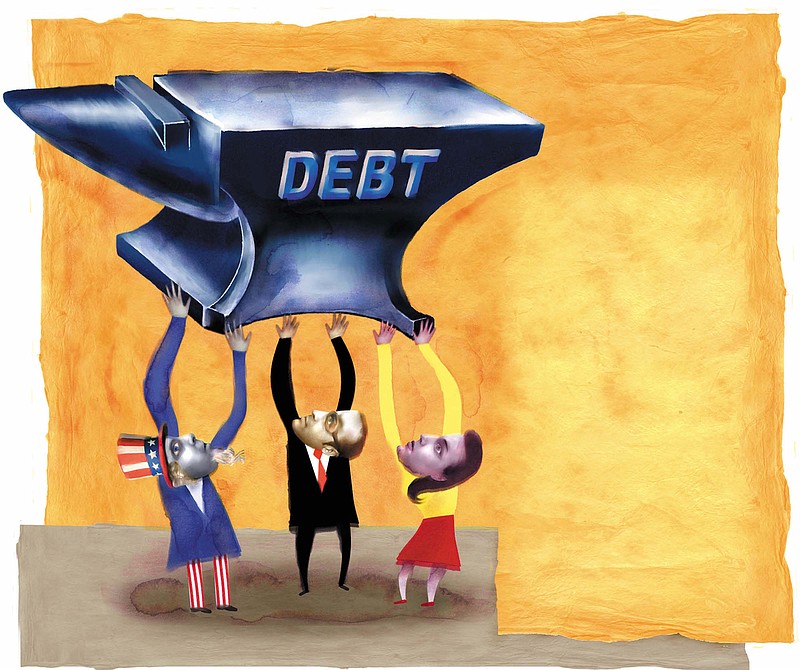In the halcyon days before the COVID-19 virus, the United States government was nearly $25 million in debt and was projected to spend $1.1 trillion more this year than it collected in taxes.
Ah, the good ol' days.
Now, in the last two months, Congress has approved about $2.4 trillion in four relief bills to alleviate the collapse of the economy from stay-at-home orders due to the virus. For perspective's sake, $2.4 trillion exceeds the individual economies of Italy, Brazil and Canada. And $240 trillion in $1 bills would stack 140 bills high on the 68.3 miles that comprise Washington, D.C.
But, wait. Speaker of the House Nancy Pelosi and her fellow Democrats want to spend more than the combined total of the first four bills on a fifth bill, a $3 trillion package that would add more more money to projects in the previous bills and tack on additional pet projects.
This from the party that only a few months ago - in an irony itself - chided President Donald Trump for the increased debt incurred in his first three years in office.
Last week, Federal Reserve Chairman Jerome Powell seemed to indicate that spending more was the preferred remedy with a record number of people out of work.
"Additional support could be costly," he said in an interview with the Peterson Institute's Adam Posen, "but worth it if it helps avoid long-term economic damage and leaves us with a stronger recovery.
"It's not the time to prioritize" concerns about fiscal spending, Powell said.
The problem with the Fed chairman's statement is that "additional support" - meaning additional debt - is what we would suggest is long-term economic damage.
Even without a fifth virus bill, the U.S. would be looking at a $3.5-$3.7 trillion increase in the debt in 2020, which, as a percentage of gross domestic product (the sum of all goods and services produced in the U.S.), would push it to levels not seen since World War II.
Pro-additional stimulus advocates argue that the debt be darned - that putting even more money in the hands of Americans and certain businesses now is what's more important.
The Great Recession offered a few lessons there. During that time, only a dozen years ago, even with a financial stimulus, the U.S. lost around $10 trillion from savings drawdowns and the falling values of homes and investments. And it hit people in lower socio-economic groups harder because they couldn't or didn't save as much and had to deplete their reserves.
Despite the end of the recession in 2009, people stayed out of the workforce, the labor market lagged and the economy grew slowly. Not until Trump was elected and put an emphasis on jobs did people return to the workforce in droves. Indeed, prior to the virus, the U.S. could cite record numbers in the workforce. If former Vice President Joe Biden is elected president in November, the country would likely to return to what former President Barack Obama said would be the "new normal" of slow growth.
Without a strong recovery, many small businesses won't make it, and those who do - especially those with government-support packages structured as loans - will have to restrict spending and hiring to concentrate on repayment. This also is likely to redound on the real estate market, which again would see little growth.
Continued financial packages also could change attitudes. Instead of seeing loans and bailouts as a last resort, Americans would see the federal trough as the first place to turn after the virus is fully under control. Such attitudes, with no thoughts toward the long-term financial future of one's children or grandchildren, would likely lessen the incentive to save or even dampen the desire to work.
For others, perhaps for those who have kept their jobs during the virus but who have become cautious about what they do have, it would cause them to reduce spending in fear of a prolonged recession or the next virus.
The uncertainty about the staying power of the virus and the length of time until a vaccine is perfected are the great variables. If we knew all businesses could reopen on June 1 and stay reopened, the limited-duration financial packages - with low rates of borrowing - make some sense. But the country's economy and its future sustainability cannot stomach four (or five) recovery packages every few months until the last American feels safe enough to return to work. Such is the key to financial ruin.
